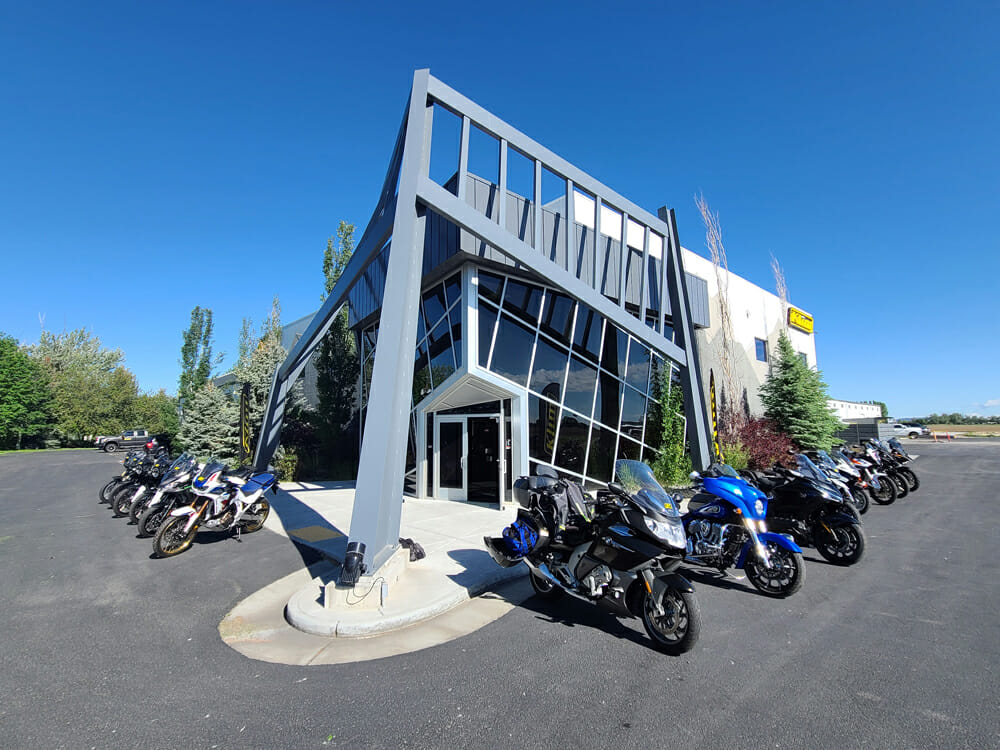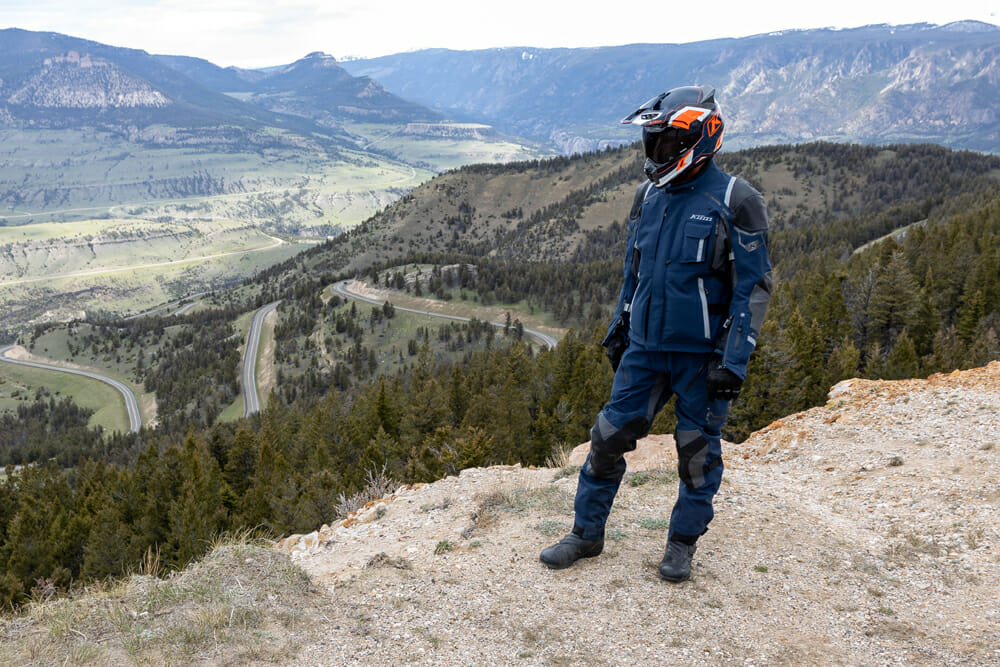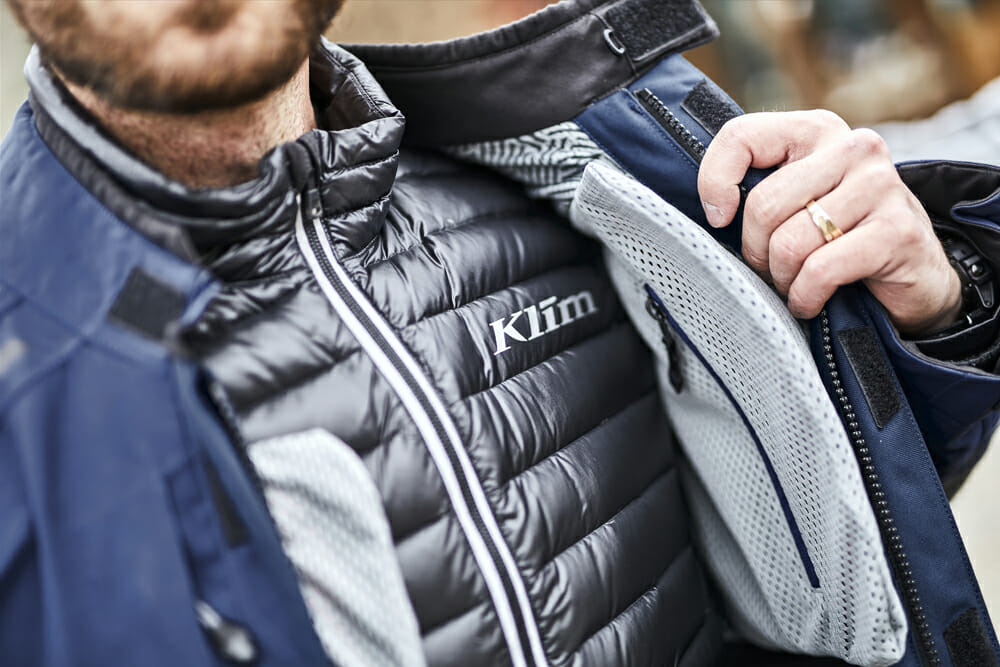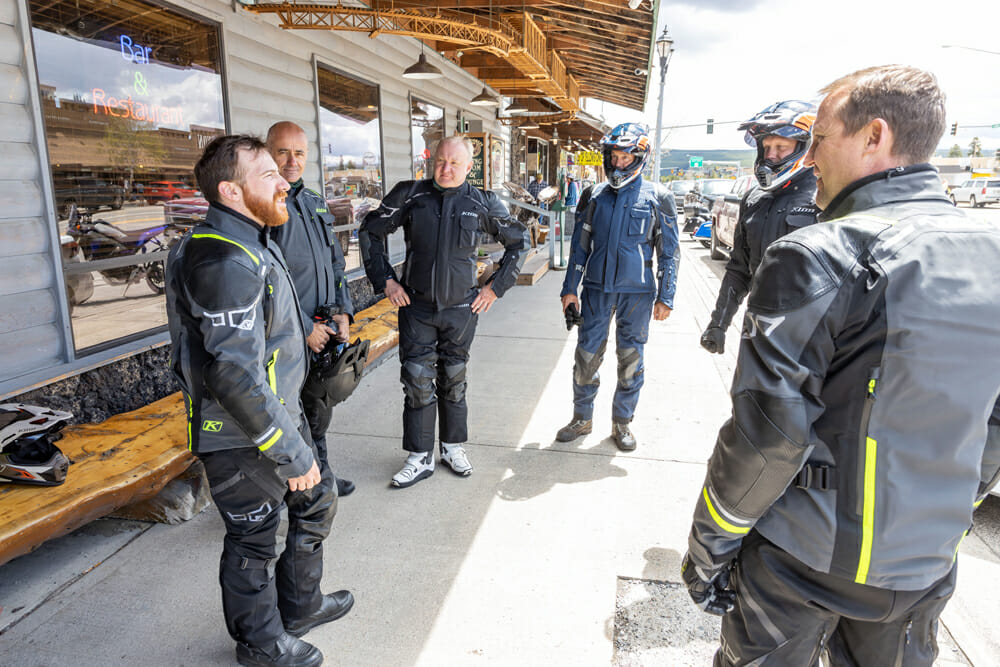Kit Palmer | June 29, 2022
The all-weather, all-terrain motorcycle gear company reminds us that it indeed knows a thing or two about road touring.
 The Grand Tetons are indeed grand.
The Grand Tetons are indeed grand.
Photography by Scott Tomlinson
We already know that Klim knows snowmobiling. And we already know Klim knows off-road and adventure motorcycle riding. But do you know that Klim also knows touring, as in hard-core Gold Wing-type road touring? Perhaps you do, but I didn’t, to be honest. I’ve always associated this Idaho-based company with anything that flings mud, snow, sand and gravel from a rear knobby tire or snowmobile track. At least that’s always been my connection to Klim—got a serious dual-sport or ADV ride coming up, call Klim. Competing in Baja, call Klim. Riding in the Mojave Desert, call Klim. However, they’ve never been near the top of my list when it comes to layering up for a lengthy pavement tour. But it is now.
Evidently, there are many folks that think like me in Europe when it comes to Klim and street touring. Klim wants to change this and have a stronger presence across the pond when it comes to street touring; after all, isn’t Europe the capital of street tours? You know, where you find the Alps, the Pyrenees, and places like that? And you also have all of Switzerland (the Alps included), where the hottest month (June) averages just 67 degrees and the average yearly rainfall is between 32 and 93 inches. In other words, you’re going to get wet and cold. Going to Switzerland for a road ride, call Klim.

But Klim isn’t the first place the Swiss (and most Europeans, for that matter) go to when it comes to touring gear; after all, what does the U.S. know about touring? Well, quite a lot, and so does Klim, and they want to spread the word around the world. So, Klim recently invited several motorcycle journalists from Europe to tour a “small” portion of the U.S. with the hope of relaying that message back to their home countries—that Klim does indeed know a thing or two about street touring on motorcycles and should be on everyone’s radar when shopping for premium road-touring gear.
The folks from Klim, who pretty much all ride motorcycles, organized a three-day tour that literally started right outside the front door of their corporate headquarters in Rigby, Idaho. From there, our group leaders had us meandering through three states—Idaho, Montana, and Wyoming—and finishing up where we departed.
 Our tour began right outside the front doors of Klim’s corporate building in Rigby, Idaho. These guys like to ride—a lot!
Our tour began right outside the front doors of Klim’s corporate building in Rigby, Idaho. These guys like to ride—a lot!
The Goods
For our ride, Klim outfitted us with its premium two-piece touring ensemble that it calls Kodiak. The Kodiak line is meant for long-distance touring, designed to keep you comfy no matter what Mother Nature throws at you. The Kodiak kit got a rebuild in early 2021 and is now available in three color combos (Stealth black, Navy blue/Monument gray, and Asphalt/Hi-Vis) and in just about every size possible. The jacket and pants have many features designed to keep you dry in the wet, warm in the cold, and cool in the heat—to keep you going when Mother Nature wants you to come inside. And Klim didn’t forget about protection or handy touring convinces, either. If you want to know a lot more about the Kodiak gear, I’ll let Klim’s own Lukas Eddy tell you. He’s the expert. Just check out the accompanying video. (And, yes, that’s the same Lukas Eddy who co-stars in our Superhard hard enduro video series. Check them out below:
VIDEO | 2022 Grinding Stone Hard Enduro: SUPERHARD! Episode 1
However, I can tell you about some of the things that stood out for me regarding the Kodiak gear. For one, the included “puffy” inner jacket that comes with the Kodiak’s main outer jacket is awesome. It’s Klim’s answer to the annoying zip-in liner. Nine times out of 10, when I un-zip a jacket liner, that’s it; it never gets zipped back in. Too much work. I’ll just replace it with a fleece sweatshirt or a motorcycling-specific undergarment (which Klim also provided us on this trip). I have a closet full of zipper liners that won’t be reunited with their mother jacket anytime soon, if ever. The super-soft puffy jacket, however, is fantastic. It is filled with Gray Goose down feathers and, when not in use, can be rolled up into a little ball and housed within itself or simply stuffed into a backpack or saddlebag without taking up much room. It’s also stylish and can be worn inside a restaurant or wherever on its own. It looks great as a regular everyday jacket. The puffy jacket, aka Maverick Down Jacket, is also sold separately for $229.99.
I found the Kodiak main jacket to fit well with or without the Maverick. The Kodiac has been cut for the touring riding position, so I felt zero stress or any pressure points on my upper body, which considerably slowed down the onset of fatigue.
 Christmas in June.
Christmas in June.
We encountered various temperature changes during our ride as we made our way over several mountain passes (some relatively high, I might add). I could easily regulate my body temperature with the puffy jacket and the many vents in both the jacket and pants. I never had an issue with being too cold or too hot. The lowest I saw was 48°F, and I wasn’t even close to uncomfortable yet.
While the Klim folks were hoping for rain to tout the Kodiac’s wet-weather capabilities, I, on the other hand, was deep down inside hoping for dry. I got my wish. But I have no reason not to believe them when they say this stuff will keep you dry in a downpour. I’ve had good luck with many of their products in the past. The Kodiak’s detachable storm collar seems like a nice touch, too. I kept mine in one of the jacket’s many pockets just in case.

If I had anything to complain about, it would be weight. The jacket feels a little on the heavy side to me, though it’s lighter than the previous generation Kodiac jacket. I guess that’s the price you pay for a jacket designed to do everything, but it really was only a small price to pay for me.
I had no issues with the Kodiak pants. Being a little on the tall side, I’ve come to expect riding pants to creep above my ankles, but the Kodiak pants are cut long enough for my 6’1” frame, though I could feel some cool (sometimes cold) air creeping up inside my pant legs while wearing Klim’s Ridgeline low-cut boots. I had no such issue when I wore my own tall boots one of the days.
 Klim’s Kodiak premium touring gear in all its glory.
Klim’s Kodiak premium touring gear in all its glory.
Klim outfitted me with a helmet, too. I was given Klim’s Krios Pro helmet, which can be worn with or without a visor, and comes with two lenses—clear and transition photochromic. I didn’t hesitate to install the transition lens and left the peak in place since I wanted to look the part on my ride, a KTM 1290 Super Adventure R. You’ll also find inside the helmet box a Pinlock anti-fog shield that I also installed.
It’s a little scary to start a three-day tour wearing a brand-new helmet that you’ve never worn before, but luckily the Krios fit my head perfectly and I had no issues with comfort, though I’m still on the fence about that Fidlock strap closure system it uses. Sometimes I fumbled with it. Sometimes it snapped together instantly. But the release part is super simple all the time compared to your standard double-D rings. Overall, I was very impressed with the Krios helmet regarding fit, feel and performance. It was relatively quiet and stayed planted on my head at speed (and some serious speed at times, I might add), even with the visor mounted in place. Plus, I like its look. It was a little bit of a squeeze to pull over my head but once in place it was all good.
 Ah, the puffy jacket, aka Maverick. It comes with the Kodiak jacket as a non-zipper liner and is one of the keys to Kodiak’s success.
Ah, the puffy jacket, aka Maverick. It comes with the Kodiak jacket as a non-zipper liner and is one of the keys to Kodiak’s success.
Get ready to pay a premium price for this premium gear. The Kodiak jacket sells for $1349.99 and the pants for $749.99. And the Krios Pro helmet is priced right up there with the big dogs at $749.99, but it does come with that wonderful $100-plus transition lens. The Ridgeline Boot sells for $229.99. This boot, by the way, is ideal for going on long walks in between rides, which is perfect for places like Yellowstone where there are many sights that you must walk to.
If these prices scare you, Klim offers another touring-focused line of gear called Latitude which is more budget-friendly. The Latitude doesn’t have all the bells and whistles of the Kodiak setup, but costs about half as much.
 Choose your Kodiak. All three color variations are pictured here: blue, black and gray.
Choose your Kodiak. All three color variations are pictured here: blue, black and gray.
VIDEO | Klim Kodiak Jacket & Pants
The Ride
We covered a fair amount of ground over the next three days. Approximately 750 miles of mostly magnificent curvy mountain roads. And a big chunk of those miles was eaten up in Yellowstone, the U.S.’s first-ever National Park. I had never been there before, so I was in awe just as much as my fellow journalists from Europe were. The scenery here is jaw-dropping, as most of you probably already know.
I learned a lot from my first experience in Yellowstone. Mainly, it’s a massive place, and being on a motorcycle makes getting from point A to point B much more accessible, quicker and less frustrating due to—at times—the crowded roads of sight-seeing tourists in cars and RVs that often park on the side of the narrow roads and clog things up to catch a glimpse of a fuzzy creature. On a bike, you just tiptoe right past everyone, peek at whatever caught their attention (usually a black bear, elk or buffalo), and keep on moving. Motorcycles rule, don’t they?
 Fooled ya! Looks cold but we weren’t. Photo: Todd Williams
Fooled ya! Looks cold but we weren’t. Photo: Todd Williams
Unfortunately, a few days after our ride, the park got hammered by flooding. Luckily for us, we left just as temperatures started to creep up, and the combination of severe thunderstorms and late-season melting snow decimated portions of the park. Some of the roads we toured have been washed away, and the entire park was forced to close. And it sounds like parts of the park won’t reopen until the end of the summer or even longer.
Someday I will be back, though, that is for sure. And for sure on two wheels and maybe even in Klim gear. Wouldn’t that be nice? CN
